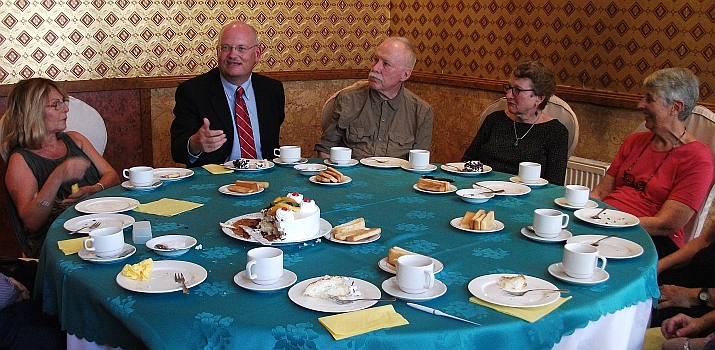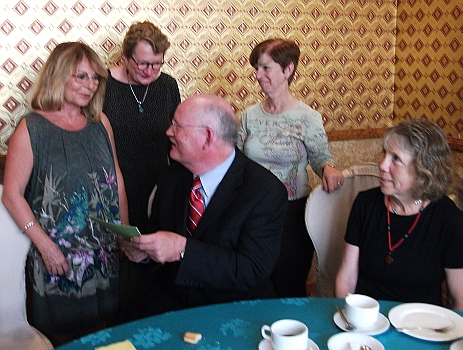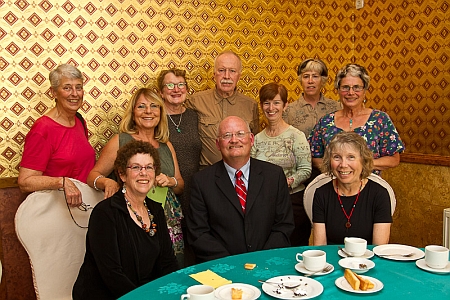![]()
August 02 - August 18, 2011
M O N G O L I A
Gobi , Altay Mountains & Hovds Gull Tour
Group Journal Day 03
Submitted by Jane Ross
HUSTAIN NURUU - PRZEWALSI HORSES, DRIVE BACK TO ULAAN BAATAR
Aug.04, 2011 Thursday
Itinerary: Drive through the
Hustain Nuruu Natural reserve to see the Przewalsi wild horses. Drive to
Ulaan Baator. stop at Gobi Kashmere Factory. After lunch meet with the
American ambassador to Mongolia, Mr.
Jonathan Addleton Dinner and
overnight at Edelweiss Hotel.
How to cook a Marmot and Przewalski (Takhi) Horses
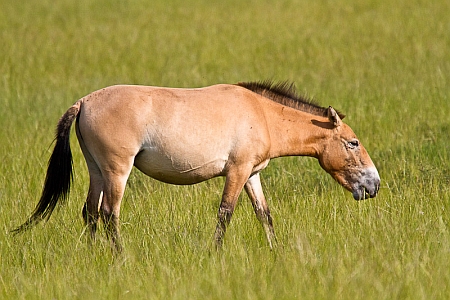 Spitting rain. Our driver, Gomba, provided fermented
mare’s milk for those hardy souls willing to get the day started with a
jolt stronger than Nescafe or tea. We discovered a delicious locally made
Karakhorum cheese at breakfast along with tasty tomatoes and a new
addition to our local diet, apples. At departure, Meli reminded us that
assumptions and opinions are not the Tour Schedule. She asked each of us
to not try to be the tour leader. She also announced schedule changes due
to changes in flight times for the rest of our tour in Mongolia. Departed
gers in Khustai National Park at 0750 in search of Mongolian wild horses,
the Takhi, also known as the Przewalski horse. Boloroo, our intelligent and beautiful guide, gave
us full bio data on the Przewalski horse. This creature, first identified
by a Russian count in 1878, disappeared from Mongolia in 1960. Fortunately
these horses had been shipped out of Mongolia to zoos in Hamburg and Kiev
in 1904. The horse was reintroduced to Mongolia in 1992 with a shipment of
62 Takhi horses from Europe . The Dutch are funding this project; there
are now 550 Takhi horses in Mongolia, with 260 living in the Khustai
National Park, and the others located in the Gobi.
Spitting rain. Our driver, Gomba, provided fermented
mare’s milk for those hardy souls willing to get the day started with a
jolt stronger than Nescafe or tea. We discovered a delicious locally made
Karakhorum cheese at breakfast along with tasty tomatoes and a new
addition to our local diet, apples. At departure, Meli reminded us that
assumptions and opinions are not the Tour Schedule. She asked each of us
to not try to be the tour leader. She also announced schedule changes due
to changes in flight times for the rest of our tour in Mongolia. Departed
gers in Khustai National Park at 0750 in search of Mongolian wild horses,
the Takhi, also known as the Przewalski horse. Boloroo, our intelligent and beautiful guide, gave
us full bio data on the Przewalski horse. This creature, first identified
by a Russian count in 1878, disappeared from Mongolia in 1960. Fortunately
these horses had been shipped out of Mongolia to zoos in Hamburg and Kiev
in 1904. The horse was reintroduced to Mongolia in 1992 with a shipment of
62 Takhi horses from Europe . The Dutch are funding this project; there
are now 550 Takhi horses in Mongolia, with 260 living in the Khustai
National Park, and the others located in the Gobi.




In the Hustai (white birch) Park, comprised of approximately 500 sq kilometers, a large number of rare species may be found: 46 mammals, 217 birds, 2 amphibians, 3 reptiles, 15 fish, 400 insects, including the ever present and well-known “Ger-bug,” Mongolian gazelles, red and roe deer, argali sheep, grey wolf, lynx, golden eagles, falcons, vultures, cranes, the great bustard, and the unforgettable marmot.
A good recipe for marmot: catch and kill the marmot; remove head and clean it out; stuff head with meat and vegetables, and red hot rocks; tie neck closed; and then use flaming blow torch to cook the outside of the marmot head, which removes the hair and provides the final cooking. We anticipate eating this version of Mongolian Bar-be-que when we soon visit the northern regions.
After returning to the ger from our photo trek, we shopped at the ger Souvenir shop, visited the small ger Museum exhibits which included a piece of Russian space trash, excellent flora and fauna photo displays, along with a description of the reclamation project of the Takhi horse. In the Conference ger we watched an excellent 15 minute video on the Khustai National Park.







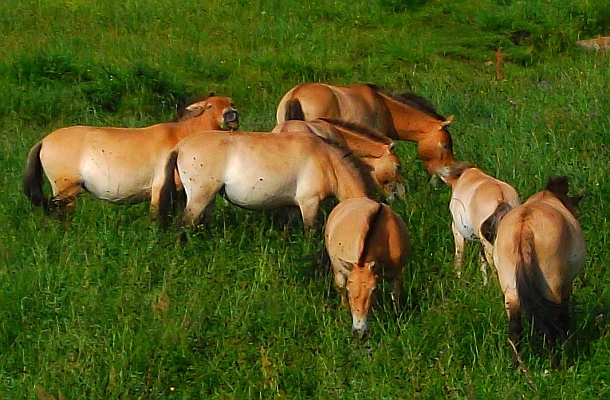


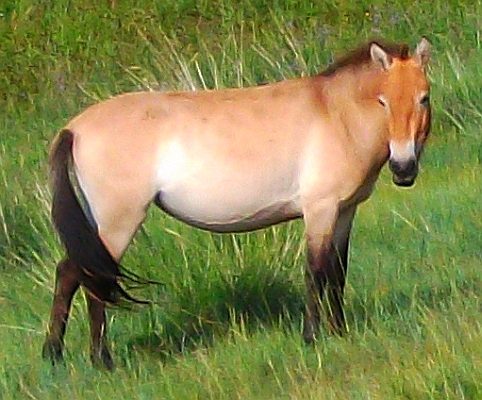
We departed for Ulan Baator: bouncing across the steppe in the bus via dirt tracks to the main road; arrived UB in time to shop for cashmere products at the Gobi factory outlet store (prices higher than at the Department Store in town and to some critical eyes, less fashionable designs); ate lunch at a Korean restaurant (non-Korean set menu included fish for the non-vegetarians – the number of “vegetarians” has now increased to seven, five of whom are temporary vegetarians – and for the vegetarians mashed potato mixed with vegetables, covered with a melted cheese slice and accompanied with a spicy tomato sauce).

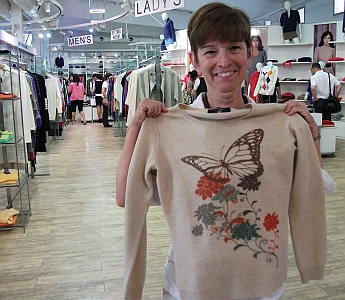
A stop at world famous Gobi cashmere
factory
A wedding celebration was taking place in the main dining room – after a dance with the groom, the bride changed from a strapless white “Western” wedding dress into traditional Mongolian dress to receive the gifts; darling children played in the hallways, and were quite willing to pose for pictures. We bought baked goods at the restaurant bakery, including a beautifully decorated cake to serve at tea during our ambassadorial meeting at 5:30.
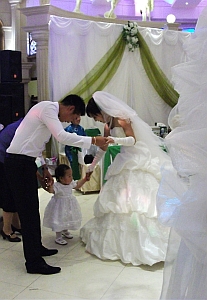
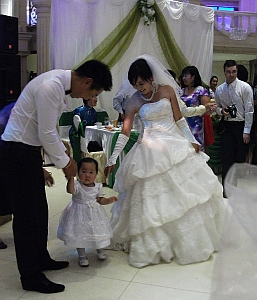
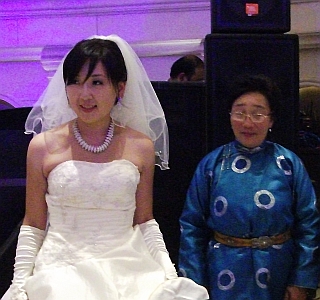
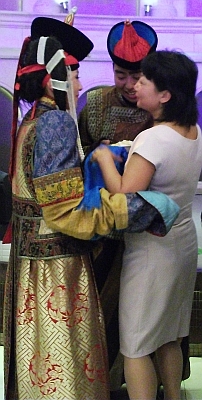 When the gift giving ceremony had started
the bride and the groom changed in to their traditional outfits.It was nice seeing the Mongolians wearing their traditional
dress, the dell and waltzing to the music of Strauss. The Mongolians have been westernized with out loosing
their traditional values.
When the gift giving ceremony had started
the bride and the groom changed in to their traditional outfits.It was nice seeing the Mongolians wearing their traditional
dress, the dell and waltzing to the music of Strauss. The Mongolians have been westernized with out loosing
their traditional values.
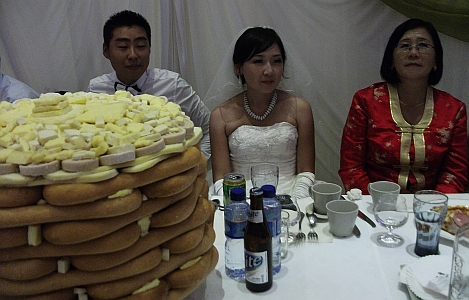
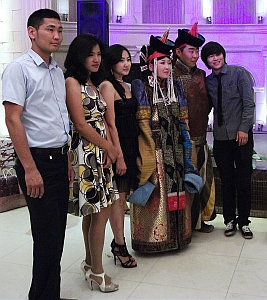
We all hit the showers in our hotel rooms en masse and looked much cleaned up for our briefing on Mongolia by the American Ambassador to Mongolia, Jonathan Addleton -- early dinner and finally to bed to prepare ourselves for the next excellent adventure in Mongolia.
